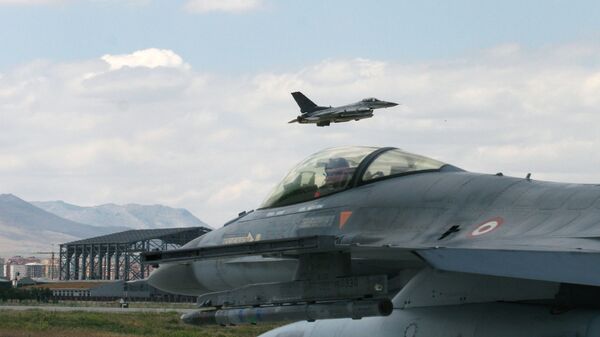Photos of Azerbaijan’s Ganja International Airport taken on October 3 by private satellite-imaging firm Planet Labs have revealed three aircraft believed to be Turkish in origin, two of which could only be F-16 Falcon fighter aircraft.
We compared the approximate measurements and visual characteristics (canard wings, color, etc.) with a variety of aircraft, including those operated by the Azerbaijani Air Force (MiG-21, MiG-29, Su-25, L-39). The Turkish-operated F-16 is the closest match. pic.twitter.com/dRCGUshyYp
— Christiaan Triebert (@trbrtc) October 7, 2020
On September 29, two days after Azerbaijan launched a renewed offensive against the autonomous, majority-Armenian region of Nagorno-Karabakh, which is supported by Armenia, the Armenian government’s official Twitter account tweeted that a Turkish F-16 flying out of Ganja air base had shot down an Armenian Su-25 ground attack aircraft. Turkey has some 245 F-16C/D models in service, bought from the United States.
#Armenian Su-25 was shot down by a #Turkish F-16 that took off from the Ganja airbase in Azerbaijan. @ArmeniaMODTeam
— Government of Armenia (@armgov) September 29, 2020
Fahrettin Altun, a senior aide to Turkish President Recep Tayyip Erdogan, told Bloomberg later that day that “the Armenian claim is false” and called it a “cheap propaganda stunt.” The involvement of a Turkish fighter in an offensive action against Armenian forces could represent a serious provocation in the region. Although the photos show F-16s at Ganja just days after the incident, that is not proof they were involved in the Su-25 shootdown, although it is a piece of evidence in Yerevan’s favor.
Armenia’s claim is further bolstered by the fact that several Turkish F-16s were openly sent to Ganja in August for joint drills, and locals took at least one photo of three F-16s in the sky just a week before the shootdown incident.
Reminder that Turkish F-16 jets were deployed to Ganja AB, Azerbaijan in July/ August under the pretext of joint exercises, but remained there. A week ago they were seen flying over Ganja city by locals (pic 3). pic.twitter.com/TEsbfwzswu
— 301🇦🇲 (@301_AD) September 29, 2020
Longstanding Turkish Support for Baku
Indeed, on October 1, Erdogan promised in his speech at the opening of the Turkish parliament’s legislative session that Turkey “will continue to support our Azerbaijani brothers with all means with all our hearts in line with the principle of 'two states, one nation,'" the state-owned Anadolu Agency reported.
"The principle of 'two states, one nation,' is not only a slogan or a historical resolve, but also a principle that dominates Turkey-Azerbaijan relations," Erdogan continued. By contrast, he derided Armenia as a “rogue state,” claiming countries supporting the Caucasian nation would have to "answer to the common conscience." Yerevan’s closest ally is Moscow.
Turkish Foreign Minister Mevlut Cavusoglu paid a visit to Baku earlier this week, during which he denounced pressure on Turkey to use its influence to calm the situation.
“We look at the calls coming from around the world, and it’s ‘immediate cease-fire.’ What then? There was a cease-fire until now, but what happened?” Cavusoglu said on Turkish television. “There can be a ceasefire, but what will be the result? Can you tell Armenia to immediately withdraw from Azeri lands? Can you come up with a solution for it to withdraw? No, it’s the same calls for 30 years.”
Erdogan’s comments strike an especially sour note, as the nationalist Young Turks movement that founded the modern Turkish state was also responsible for the genocide of nearly 1.5 million Armenians in the Ottoman Empire in the closing years of World War I. Ankara denies the killings were genocidal, but 32 nations, including the United States and Russia, recognize the mass deaths and expulsions as a genocide.
Armenia and Azerbaijan are both former republics of the Soviet Union, which was dissolved in 1991. The breakup saw Armenians and Azeris who had formerly lived in the same nation now on opposite sides of a complex web of territories in the eastern Caucasus region, but conflict actually broke out in 1988, nearly three years before the republics were separated from Moscow. A 1994 ceasefire established de facto autonomy for Nagorno-Karabakh, which sits inside Azerbaijan and shares a border with Iran.


